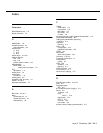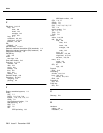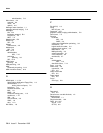
Glossary
Issue 2 December 1995 GL-19
simplified message service interface (SMSI)
Type of data link connection to an integrated 1A ESS switch or 5ESS switch in the INTUITY sys-
tem.
single in-line memory modules (SIMMs)
A method of containing random access memory (RAM) chips on narrow circuit card strips that
attach directly to sockets on the CPU circuit card. Multiple SIMMs are sometimes installed on a
single CPU circuit card.
small computer systems interface (SCSI)
An interface standard defining the physical, logical, and electrical connections to computer sys-
tem peripherals such as tape and disk drives.
SMSI
See
simplified message service interface
.
split
Group (or queue) of analog ports on the switch. See also
call-distribution group
.
subscriber
An INTUITY user who has been assigned the ability to access the INTUITY AUDIX Voice Messag-
ing system.
surge
A sudden voltage rise and fall in an electrical circuit.
surge protector
A device that plugs into the phone system and the commercial AC power outlet. It is designed to
protect the phone system from high voltage surges that could be damaging to the phone system.
switch
An automatic telephone exchange that allows the transmission of calls to and from the public tele-
phone network. See also
private branch exchange (PBX)
.
switched access
A connection made from one endpoint to another through switch port cards. This allows the end-
point (such as a terminal) to be used for several applications.
switch hook
The device at the top of most telephones which is depressed when the handset is resting in the
cradle (on hook). This device is raised when the handset is picked up (the phone is off hook).
switch hook flash
A signaling technique in which the signal is originated by momentarily depressing the switch
hook.
switch network
Two or more interconnected switching systems.
synchronous communication
A method of data transmission in which bits or characters are sent at regular time intervals, rather
than being spaced by start and stop bits. See also
asynchronous communication
.
synchronous transmission
A type of data transmission where the data characters and bits are exchanged at a fixed rate with
the transmitter and receiver synchronized. This allows greater efficiency and supports more pow-
erful protocols.
system configuration
See
configuration
.


















